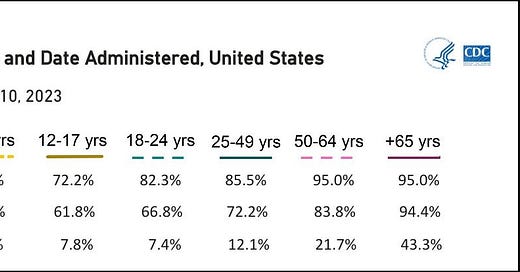COVID-19: NEWLY PUBLISHED RESEARCH AND CDC DATA
5.6 in 1000 (1 in ~180) people had a stroke after Covid-19 “vaccination” within a 21 day period.
COVID-19: NEWLY PUBLISHED RESEARCH AND CDC DATA
Below are two of three papers recently re-published by Dr Robert Malone.
The Bad News: 5.6 in 1000 (1 in ~180) people had a stroke after Covid-19 “vaccination” within a 21 day period.
The Good News: Americans are avoiding the third (booster) shots – except for some older folks.
I’m telling you yet again: “Get smart – save your lives!”
- NO more toxic Covid-19 injections, for anyone!
- Get treatment for the vaxxed NOW.
Two of my expert medical friends wrote me re C-19-vaxx-treatment as follows:
“Nattokinase, Quercetin, NAC, Olive Leaf and higher doses of Vitamin D and C.
Adding Olive Leaf to TWC's Spike Support which also has Dandelion Root and Black Seed (Nigella Sativa).
I usually also take Elderberry.”
Regards, Allan MacRae. Calgary
THE TRUTH SETS PEOPLE FREE
Robert W Malone MD, MS Jul 20, 2023
[excerpts]
Recently, there have been a couple of interesting papers published concerning mRNA COVID-19 vaccines. These are papers that for some reason haven’t made it to main-stream media. Let’s take a look.
Factors associated with stroke after COVID-19 vaccination: a statewide analysis
In plain language, 5.6 in 1000 people had a stroke after “vaccination” within a 21 day period.
Front Neurol 2023 Jun 28;14:1199745. doi: 10.3389/fneur.2023.1199745. eCollection 2023.
Abstract
Background: The objective of our study was to evaluate vaccine type, COVID-19 infection, and their association with stroke soon after COVID-19 vaccination.
Methods: In a retrospective cohort study, we estimated the 21-day post-vaccination incidence of stroke among the recipients of the first dose of a COVID-19 vaccine. We linked the Georgia Immunization Registry with the Georgia Coverdell Acute Stroke Registry and the Georgia State Electronic Notifiable Disease Surveillance System data to assess the relative risk of stroke by the vaccine type.
Results: Approximately 5 million adult Georgians received at least one COVID-19 vaccine between 1 December 2020 and 28 February 2022: 54% received BNT162b2, 41% received mRNA-1273, and 5% received Ad26.COV2.S. Those with concurrent COVID-19 infection within 21 days post-vaccination had an increased risk of ischemic (OR = 8.00, 95% CI: 4.18, 15.31) and hemorrhagic stroke (OR = 5.23, 95% CI: 1.11, 24.64) with no evidence for interaction between the vaccine type and concurrent COVID-19 infection. The 21-day post-vaccination incidence of ischemic stroke was 8.14, 11.14, and 10.48 per 100,000 for BNT162b2, mRNA-1273, and Ad26.COV2.S recipients, respectively. After adjusting for age, race, gender, and COVID-19 infection status, there was a 57% higher risk (OR = 1.57, 95% CI: 1.02, 2.42) for ischemic stroke within 21 days of vaccination associated with the Ad26.COV2.S vaccine compared to BNT162b2; there was no difference in stroke risk between mRNA-1273 and BNT162b2…
Overall, 473 (9.498 per 100 thousand) had ischemic stroke, and 87 (1.747 per 100 thousand) subjects had developed hemorrhagic stroke within 21 days post-vaccination. The 21-day post-vaccination incidence of ischemic stroke was 8.14, 11.14, and 10.48 per 100,000 for BNT162b2, mRNA-1273, and Ad26.COV2.S recipients, respectively; after adjusting for age, race, gender, and COVID-19 infection status, there was a 57% higher risk (OR = 1.57, 95% CI: 1.02, 2.42) for ischemic stroke within 21 days of vaccination associated with Ad26.COV2.S vaccine compared to BNT162b2 (Table 2). There was no difference seen in the risk of stroke between mRNA-1273 compared to BNT162b2. After adjusting for age, race, gender, and COVID-19 infection status, those with concurrent COVID-19 infection had an increased risk of ischemic (OR = 8.00, 95% CI: 4.18, 15.31) and hemorrhagic stroke (OR = 5.23, 95% CI: 1.11, 24.64). There was no statistical evidence for an interaction between vaccine type and concurrent COVID-19 infection.
In plain language, 5.6 in 1000 people had a stroke after “vaccination” within a 21 day period. The J&J product was associated with more strokes than the Pfizer or Moderna products. Those who were “vaccinated” with concurrent COVID-19 infections had an increased risk of either type of stroke.
More data from the CDC indicates that Americans are done with mRNA COVID-19 injections.
Just look at the rates of booster administered.
This must be causing some heartburn among the public health administrative set.
Concentrating on the pediatric population (kids)…
In babies and kids up to four years old, only 0.6% are fully vaccinated. About 5% have completed the primary series and 9% to 11% have had at least one dose.
The 5-11 year olds also are no longer getting vaccinated. Less than 5% have had a booster and only 33% have completed the 2-shot series.
It is believed that not being able to do extracurricular activities without vaccination, caused the 12-17 year olds to get vaccinated. But the good news is that only 8% have been boosted.
Frankly, these numbers are extraordinary. Parents are no longer vaccinating with this experimental vaccines.
The vast majority of adults have not had a booster!
I think we all deserve a big thanks for spreading the message. This is a world-wide group effort to fight big pharma and big government(s) controlling the narrative and we are winning!





A reader sent me this:
Looks about right.
https://stopworldcontrol.com/what/